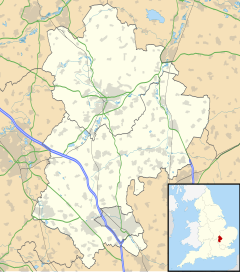Billington, Bedfordshire
| Billington | |
|---|---|
 Parish church of St Michael and All Angels, Great Billington |
|
| Billington shown within Bedfordshire | |
| Population | 632 (2001) 291 (2011 Census) |
| OS grid reference | SP9422 |
| Civil parish |
|
| Unitary authority | |
| Ceremonial county | |
| Region | |
| Country | England |
| Sovereign state | United Kingdom |
| Post town | LEIGHTON BUZZARD |
| Postcode district | LU7 |
| Dialling code | 01525 |
| Police | Bedfordshire |
| Fire | Bedfordshire and Luton |
| Ambulance | East of England |
| EU Parliament | East of England |
| UK Parliament | |
Billington is a civil parish in Bedfordshire about 3 miles (4.8 km) south of Leighton Buzzard and not far from the Buckinghamshire border. There are two settlements: Little Billington (a hamlet in the west of the parish) and one that is now called Great Billington (straddling the A4146).
At the 2001 census, the parish had a population of 632, although by the 2011 Census the population had fallen to 291. The name of the parish is recorded in 1196 as Billendon, and may come from Anglo-Saxon language Billan dūn = "hill of a man named Billa". Another theorized original meaning is "hill with a sharp ridge". The spelling Billyngdon appears in a legal record, dated 1440, where Hugh and Thomas Billyngdon of Billyngdon, Beds, gentlemen, are mentioned.
The centre of Great Billington is Billington Hill, on top of which is the small parish church. An Iron Age fort and settlement once occupied this site. The church was originally a small mediaeval chapel; however, in the late 1860s it was enlarged to a church, and a rectory built next to it to house the first incumbent. This was when Billington was first recorded as a parish in its own right. The bell turret of the church (it has no tower) came to the church secondhand, from the church at nearby Linslade, which too was being enlarged at the time. The interior of the church is very simple; a small stained glass window in the west wall commemorates Edward Bradshaw, the first rector.
The village once had a common, where the peasants cultivated their own strips of land; the name 'common' still survives as a field name. It was enclosed at the time of the enclosures, and is today part of a local farm. It is traversed by two public footpaths.
The village contains some half-timbered thatched cottages, in the area around the summit of the hill, and also some old farmhouses and cottages. One of the thatched cottages on top of the hill has the dubious honour of having featured on countless chocolate boxes and biscuit tins. One of the more attractive houses in the village is Walkers Farm, a brick and timber house dating from the 16th century. Its once-thatched roof is now tiled.
...
Wikipedia

